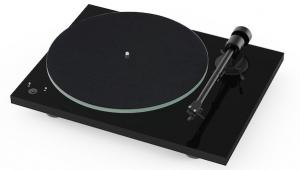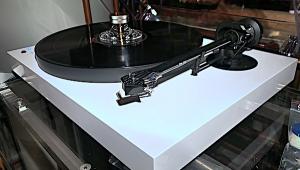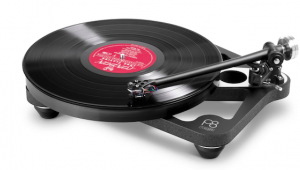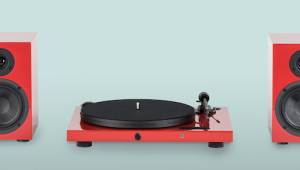Simon Yorke Designs Series 7 Precision LP Playback System Page 3
Was I hearing the arm or the 'table? The only way to find out was to mount the Graham and Immedia arms on the Yorke 'table and listen some more. I ended up with the Yorke/Immedia/Graham on the Zoethecus constrained-layer-damped equipment stand, and the TNT on the Vibraplane (it barely fit, and I couldn't use the flywheel), and then on the Symposium board on the Vibraplane (everything fit with ease, including flywheel). I also varied the amount of air in the four TNT towers from none to overinflated, just to see what effect it would have on the sound. And I removed the Vibraplane altogether. While all of these changes affected the sound, the TNT's basic character, as I've come to know and love it over the years, remained.
Eventually I realized I could move the Graham arm (fitted with a new, broken-in Koetsu Urushi) from one 'table to the other in a matter of a few minutes, and that's how I did my final evaluation of the two 'tables—and of the Yorke arm, which I'll deal with first.
During my evaluation I discovered a design flaw: because of where Yorke chose to apply anti-skating (below the pivot point), there is an interaction between the anti-skating side force and VTF. In fact, using the Winds Arm Load Meter, I found that the Yorke arm, set to track at 1.8gm at the lead-in groove area, was down to 1.4gm at the lead-out groove—not a good thing! You ought to check your own arm's tracking-force consistency. Fortunately, there's an easy fix for this that Yorke will incorporate in future production, and which is retrofittable in a matter of minutes.
That said, the Yorke arm's tonal balance is virtually seamless and neutral, both in the midrange and at the frequency extremes. It is, in that respect, the equal of the finest arms I've ever heard—on a par with the Graham, Triplanar, ET, Immedia, Rockport, etc. Its image focus, bass response, and dynamic presentation are also first-rate, and its measured horizontal and vertical resonance points are where you want them: above warp/wow and below the music. Yorke has done his homework.
But the arm does have a few minor deficiencies: as I discovered after switching to either the Graham or Immedia arms, the Yorke arm, not the 'table, is the cause of the slight but noticeable soundstage congestion, the shortage of air, and the less-than-first-class image delineation. It is the arm, not the 'table, that fails to retrieve and resolve the last layer of inner detail, and fails to provide the kind of jet-black background spaces between instruments. But these are very slight losses, discernible only in direct A/B comparisons. Otherwise, the Yorke arm strikes an almost ideal musical balance between etchy, clinical delineation of detail and overly lush, "soft," romantic, "audiophile" sound.
I ran into one tracking problem with the Yorke arm. Fitted with the Transfiguration Temper cartridge, it suffered a bit of breakup tracking the admittedly difficult-to-navigate finale of Rachmaninoff's Piano Concerto 3 with Ashkenazy (Previn/LAPO, on the new Super Analogue pressing, KIJC-9204). This was after I'd made the anti-skating modification and checked all other setup parameters. When I moved that cartridge to the Immedia arm, the sailing was much smoother, as it was with the Urushi/Graham combo. But that was the only record I came across that caused an audible problem.
Yorke 'table/Graham arm/Koetsu Urushi vs TNT/Graham/Urushi
The Graham 2.0 on the Yorke 'table improved on what already was impressive performance. The overall sonic picture became better organized, with the kind of superb soundstaging performance to which I'd become accustomed with the Graham on the TNT. I got all of the width, depth, and height I expected, and the air and instrumental separation I crave hearing. Plus, I got the substantial improvement in bass focus and clarity I noted with the Yorke arm/'table combo.
On the title cut from Roxy Music's Avalon (British Polydor Super Deluxe EGHP 50) I heard every familiar tiny percussive detail, every nuance in the spectacular mix, arrayed across a gigantic soundstage—but with some notable new pluses compared to the TNT: better bass focus, improved top-to-bottom tonal integration, and a new, smoother, more natural texture to the female backup voices. Less etch, more flesh.
Moving the arm to the TNT, I got softer, less well-controlled, but equally deep bass, warmer midbass but leaner midrange, plus a bit more edge definition to high-frequency transients and an overall slightly brighter sound in a narrow high-frequency band. And there was a bit more "blackness" to interstitial silence. Of course, the TNT was on the Vibraplane. I ended up with the Yorke on the Vibraplane, but still felt the TNT offered a slightly quieter background.
Once you reach this level of performance, you're talking more about tradeoffs than anything else. Both of these well-built 'tables are superb performers with much to offer the well-heeled analog lover, but after much gnashing of teeth, agonizing, and personal torment I decided that, after 10 (count 'em) 10 years of TNT loyalty, I had been won over by the Yorke's undeniably superior bass performance, its rhythmic certitude, its richer, smoother overall tonal balance, and its ability to delineate layers of front-to-back information totally free of etch.
To my ears, overall, it is the best-balanced, most seamless-sounding turntable I've ever heard—especially when used in conjunction with the Vibraplane isolation stand with which it's packaged domestically (footnote 1). That it is compact, simple, conveniently plays 78s, and can support two arms simultaneously, made my decision somewhat easier. I will miss TNT's continuously variable speed control, its ease of changing armboards, and many of its sonic attributes. But I'm looking forward to those sonic qualities the Yorke possesses that the TNT does not.
Conclusion
Though I think both the Graham and Immedia arms offer incremental improvements—more focused bass, somewhat better "organizational skills," and perhaps slightly better tracking—and both mate exceedingly well with the Yorke 'table, the complete system as designed and built by Simon Yorke is a formidable analog playback system, a masterful work of visual and sonic art that's hard to fault.
It provides a gloriously cohesive, always musical sound—a superbly balanced sonic picture that combines deep, tightly focused bass, free of overhang and low-frequency coloration, with extended, detailed edge- and etch-free high frequencies devoid of brightness or exaggeration. The mids are lush yet detailed, and equally well focused and naturally presented. The picture is completed with superb imaging and soundstaging, with convincing front-to-back depth, and well focused but natural-sounding instrumental layering. There's nothing "hi-fi" about the Yorke combo; it just sounds musically "right," whether handed hard rock or Heifetz. No wonder every audiophile who's come down lately has said, "Your system's never sounded better."
Footnote 1: But stay tuned—there are more contenders to come.
- Log in or register to post comments




















































